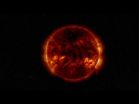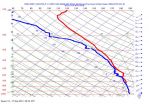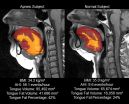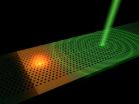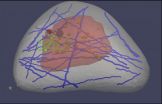(Press-News.org) CINCINNATI—The potential for doctors to measure damaging "brain tsunamis" in injured patients without opening the skull has moved a step closer to reality, thanks to pioneering research at the University of Cincinnati (UC) Neuroscience Institute.
The research team, led by Jed Hartings, PhD, research associate professor in the department of neurosurgery at the UC College of Medicine, has shown that spreading depolarizations—electrical disturbances that spread through an injured brain like tsunami waves—can be measured by the placement of electroencephalograph (EEG) electrodes on the scalp. The team demonstrated the effectiveness of the noninvasive technique by making simultaneous invasive recordings from electrodes that were placed directly on the surface of the brain in 18 patients who had undergone surgery following a traumatic brain injury (TBI).
"We can see clearly when spreading depolarizations occur with invasive recordings," Hartings says. "And when we looked at this data side by side with the non-invasive EEG recordings, it just jumped out at us. When you look at the scalp EEG the right way, evidence of the spreading depolarization could be seen."
The discovery has the potential to revolutionize bedside neuro-monitoring by enabling doctors to measure spreading depolarizations, which lead to worse outcomes, in patients who do not require surgery. At present, only about 10 to 15 percent of patients with TBI undergo surgery and are candidates for intracranial monitoring.
"This landmark observation broadens the spectrum of patients and conditions that can be monitored for the occurrence of spreading depolarizations," says co-investigator Norberto Andaluz, MD, associate professor of neurosurgery and director of the UC Neurotrauma Center at the UC Neuroscience Institute. Until now, spreading depolarizations could only be detected through the insertion of surgical leads into the patient's brain. Thanks to this discovery, we will acquire a better understanding of the role that depolarizations play in virtually every neurological condition, thus opening new opportunities for therapeutic interventions."
The research was published online in the journal Annals of Neurology earlier this month and highlighted online in the journal Nature Reviews. The research was funded by the U.S. Army's Psychological Health and Traumatic Brain Injury (PH/TBI) Research Program and the Mayfield Education & Research Foundation.
The discovery was not made sooner because of historical conventions in how scalp EEG data is reviewed, Hartings says. Continuous EEG is typically studied in small 10-second segments, which allows detection of abnormal brain waves, such as epileptic spikes, which last fractions of a second. The changes associated with spreading depolarizations, on the other hand, develop over tens of minutes.
When the data is time-compressed so that hours of EEG recordings are presented on a single screen, the picture comes into focus. "The pattern jumps out at you," Hartings says. "Suddenly, what you see developing over a course of 45 minutes is a depression of the amplitude of the brainwaves. It takes maybe 15 minutes for that to develop to its minimum, and then it will slowly recover again over another 15 to 20 minutes. So you can only see the depolarization when you are looking at long epochs of data.
"This is something that people have probably been recording for 50 years," Hartings adds, "but they weren't looking at the data in the right way to be able to recognize it."
Hartings likened the phenomenon to the Nazca Lines, the famous geoglyphs in the desert of southern Peru. The Nazca Lines suggest nothing up close, but when seen at a distance from surrounding foothills or an airplane, images of artistry emerge.
In the Annals of Neurology study, the researchers reported on spreading depolarizations that lasted from 10 minutes to several hours. More than 80 percent of the depolarizations could be detected with scalp EEG.
Bringing the "Nazca Lines of the brain" into focus from the patient's bedside is a primary objective of Hartings' research, which has played a leading role worldwide in the understanding of spreading depolarizations in acute neurologic injury. Hartings' team characterized the phenomenon in TBI and laid the foundation for understanding its destructive nature in research published in Lancet Neurology and Brain in 2011.
"One of our main objectives going forward is to develop techniques for measuring spreading depolarizations non-invasively, using a more traditional EEG," Hartings says.
Because the spreading depolarizations range from subtle to obvious, more research is needed. "If the activity is subtle, perhaps we can we use digital signal processing techniques to make the signal more obvious," Hartings says. "Can we define data processing procedures that will clean up the signal and maybe even establish criteria that will set off an automatic alarm to alert bedside physicians?"
Translating and refining this knowledge into a broadly applicable methodology with a refined user-friendly bedside display, Hartings says, is perhaps five years away.
INFORMATION:
Additional co-investigators of the study included J. Adam Wilson, PhD, Jason Hinzman, PhD, Sebastian Pollandt, MD, Vince DiNapoli, MD, PhD, and David Ficker, MD.
Andaluz is a neurosurgeon with the Mayfield Clinic, and Ficker is a UC Health neurologist and director of the EEG Laboratory and the Epilepsy Monitoring Unit at the UC Neuroscience Institute.
Researchers show EEG's potential to reveal depolarizations following TBI
2014-09-30
ELSE PRESS RELEASES FROM THIS DATE:
NASA's Swift mission observes mega flares from a mini star
2014-09-30
On April 23, NASA's Swift satellite detected the strongest, hottest, and longest-lasting sequence of stellar flares ever seen from a nearby red dwarf star. The initial blast from this record-setting series of explosions was as much as 10,000 times more powerful than the largest solar flare ever recorded.
"We used to think major flaring episodes from red dwarfs lasted no more than a day, but Swift detected at least seven powerful eruptions over a period of about two weeks," said Stephen Drake, an astrophysicist at NASA's Goddard Space Flight Center in Greenbelt, Maryland, ...
NASA's HS3 looks Hurricane Edouard in the eye
2014-09-30
NASA and NOAA scientists participating in NASA's Hurricane and Severe Storms Sentinel (HS3) mission used their expert skills, combined with a bit of serendipity on Sept. 17, 2014, to guide the remotely piloted Global Hawk over the eye of Hurricane Edouard and release a sonde that rotated within the eye as it descended and fell into the eyewall of the storm at low levels.
NASA's HS3 mission has returned to NASA's Wallops Flight Facility on the Eastern Shore of Virginia for the third year to investigate the processes that underlie hurricane formation and intensity change ...
Study shows that tongue size and fat may predict sleep apnea risk in obese adults
2014-09-30
DARIEN, IL – A new study of obese adults is the first to show that those who have obstructive sleep apnea have a significantly larger tongue with a higher percentage of fat than obese controls. This may provide a mechanistic explanation for the relationship between obesity and sleep apnea.
Results show that obese participants with sleep apnea had significantly greater tongue volumes, tongue fat and percentage of tongue fat than obese controls without sleep apnea, after adjusting for potential confounders such as age, body mass index (BMI), gender and race. Further analysis ...
Ultrafast remote switching of light emission
2014-09-30
This news release is available in German.
The researchers etched a photonic crystal around several quantum dots in a semiconductor layer. Quantum dots are small structures that spontaneously emit light as a consequence of atomic processes. If a short laser pulse is fired at the photonic crystal, its refractive index is modified and the quantum dot experiences a change in the electromagnetic field around it. This change can speed up or slow down the emission of light by the dot. As soon as the refractive index recovers its usual value, the dot emits light again ...
'Virtual breast' could improve cancer detection
2014-09-30
Next to lung cancer, breast cancer is the leading cause of cancer death in women, according to the American Cancer Society. That's why so many medical professionals encourage women to get mammograms, even though the tests are imperfect at best: only a minority of suspicious mammograms actually leads to a cancer diagnosis.
That results in lots of needless worry for women and their families—not to mention the time, discomfort and expense of additional tests, including ultrasounds and biopsies.
Recently, a different type of test, ultrasound elastography, has been used ...
Rehospitalization in younger patients
2014-09-30
Older adults often are readmitted after hospitalization for heart failure, pneumonia, and acute myocardial infarction, a significant issue that has caused Medicare to target hospitals with high 30-day readmission rates for financial penalties. Older adults are also often admitted for reasons other than the original hospitalization. This vulnerability to readmission has been referred to as "post-hospital syndrome." However, whether younger patients also experience a similar pattern of readmission has not been well studied.
In a large cohort study, Isuru Ranasinghe and ...
Diuretics in proton pump inhibitor-associated hypomagnesemia
2014-09-30
Proton pump inhibitor (PPI) therapy is associated with hospitalization for hypomagnesemia, particularly among patients also receiving diuretics, according to research published this week in PLOS Medicine. The study, conducted by David Juurlink of the University of Toronto and colleagues, suggests that physicians reconsider long-term PPI therapy for patients with a diagnosis of hypomagnesemia or concurrent use of diuretics.
Roughly 145 million prescriptions for PPI are dispensed in the United States annually for acid-related disorders such as dyspepsia and gastroesophageal ...
At dusk and dawn: Scientists pinpoint biological clock's synchronicity
2014-09-30
Scientists have uncovered how pacemaker neurons are synchronized at dusk and dawn in order to maintain the proper functioning of their biological clocks. Their findings, which appear in the journal PLOS Biology, enhance our understanding of how sleep-wake cycles are regulated and offer promise for addressing related afflictions.
"We've known for some time that the time-keeping of our biological clocks is a complex enterprise," says New York University's Justin Blau, a professor of biology and neural science and one of the study's co-authors. "But our results offer new ...
How dinosaur arms turned into bird wings
2014-09-30
Although we now appreciate that birds evolved from a branch of the dinosaur family tree, a crucial adaptation for flight has continued to puzzle evolutionary biologists. During the millions of years that elapsed, wrists went from straight to bent and hyperflexible, allowing birds to fold their wings neatly against their bodies when not flying.
How this happened has been the subject of much debate, with substantial disagreement between developmental biologists, who study how the wings of modern birds develop in the growing embryo, and palaeontologists who study the bones ...
Study shows how chimpanzees share skills
2014-09-30
Evidence of new behaviour being adopted and transmitted socially from one individual to another within a wild chimpanzee community is publishing on September 30 in the open access journal PLOS Biology. This is the first instance of social learning recorded in the wild.
Scientists from University of St Andrews, University of Neuchâtel, Anglia Ruskin University, and Université du Quebec studied the spread of two novel tool-use behaviours among the Sonso chimpanzee community living in Uganda's Budongo Forest. Dr Catherine Hobaiter, Lecturer in Psychology at the University ...
